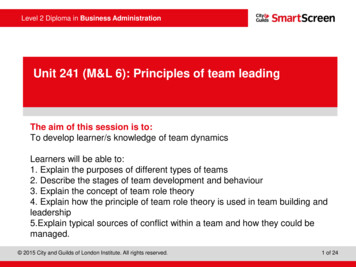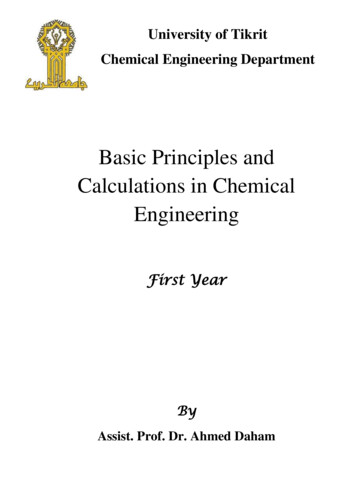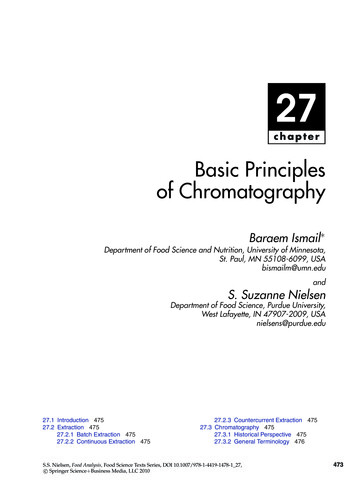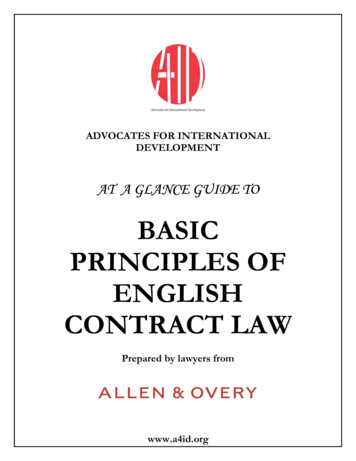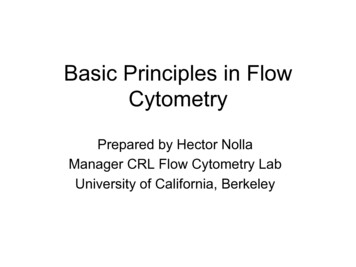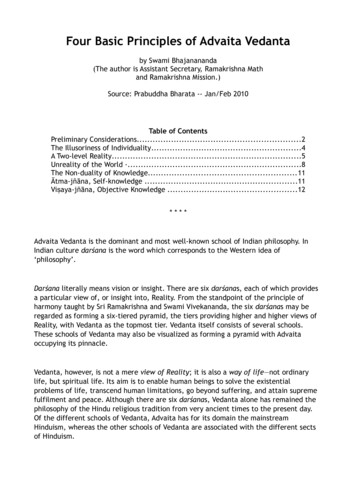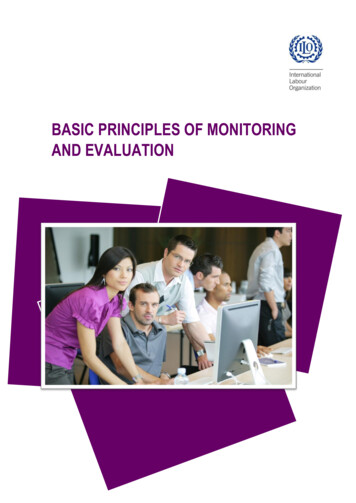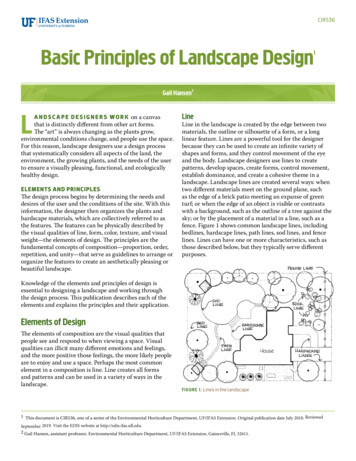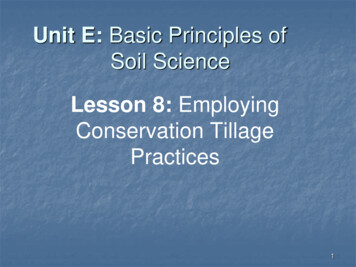
Transcription
Unit E: Basic Principles ofSoil ScienceLesson 8: EmployingConservation TillagePractices1
Terms illageCrop rotationDouble croppingOrganic farming Post emergencetillagePre-plant tillagePrimary tillageSecondary tillageSustainableagricultureTillage2
What are the various uses oftillage? Tillage is working the soil to provide afavorable environment for seed placement,germination, and crop growth.To grow properly, seeds need a moist soilat the appropriate temperature withsufficient air for seed respiration.The seedbed should be loose enough forgood aeration, yet compact enougharound the seed for good soil-seedcontact. It should be free of clods thatprevent proper seedling emergence.3
There are a variety of tillage systemoptions available to the crop producer.However, there are three basic goals thatmust be met by whatever tillage system aproducer decides to utilize. Those threegoals are: weed control, physical soilconditions, and crop residue management.4
Weed control The importance of tillage for weedcontrol has declined with the increase inherbicide use. Some herbicides are incorporated intothe soil by shallow tillage. Tillage for weed control can be dividedinto two time periods.5
Pre-plant tillage is tillage of the soilbefore the crop is planted. This tillage prepares a weed freeseedbed that reduces the weedpressure during the growing season. This tillage is designed to destroyyoung weed seedlings.6
Post emergence tillage is tillage donebetween rows of growing crops. This cultivation is designed to destroyor bury emerging weed seedlings. Deep cultivation or cultivation late inthe growing season could sever croproots.7
Physical soil conditions Tillage alters physical soil propertiessuch as structure, moisture, andtemperature. Tillage during seedbed preparation stirsand loosens soil, improves aeration, andcreates a suitable medium for plantgrowth. Deep tillage and subsoiling maytemporarily break up subsoilcompaction.8
Crop residue management After a crop is harvested, residues likestalks or leaves remain in the field. The amount of residue depends on thetype of crop, how well it grew, and how itis harvested. Different tillage methods leave varyingamounts of crop residue on the surfaceof the soil.9
What is conventional tillage? Conventional tillage is a tillage systemmade up of two stages, primary andsecondary tillage. Primary tillage breaks up the soil andburies crop residues. This is oftenaccomplished with a soil invertingimplement, like a plow. Secondary tillage produces a fineseedbed by a series of operations thatbreak up the soil into smaller andsmaller chunks.10
The traditional primary plowing tool is themoldboard plow. The moldboard plow shears off asection of soil, tips it upside down, andfractures it along several planes. Duringthis process, any organic matter on thesoil surface is buried. When finished, this implement leavesthe soil surface very rough with a seriesof ridges and furrows.11
Moldboard Plow12
Other primary tillage tools are the discplow and subsoilers. A disc plow is an implement with aseries of three to ten large discsmounted on a frame at an angle to thedirection of travel.13
Disc Plow14
Secondary tillage is usually a two-stepprocess. First ridges left from plowing aresmoothed out and large clods arebroken. Then smaller lumps arepulverized and a fine seedbed isproduced. The first step is commonlyaccomplished with a tandem disc.15
The typicaltandem disc hasfour gangs ofdiscs set like thefour arms of an“X.” The fronttwo gangs turnthe soil inward,and the back twoturn it back out.16
A spring-tooth harrow can also be used insecondary tillage. This implement is made of long, springy,C-shaped teeth with a shear point orbroad shovel that digs into the soil,dragging clods to the surface andbreaking them up. A finishing harrow or drag is used topulverize the soil clods into a smooth,fine surface.17
Spring-tooth harrow18
What is conservation tillage? Conservation tillage is a tillage programaimed at reducing erosion by leaving cropresidues on a rough soil surface. Rather than plowing under cropresidues, some or all of the residue isleft exposed.19
The definition of conservation tillage hasrequired that, at planting, 30 percent ormore of the soil surface be covered withcrop residues. Conservation tillage reduces water andwind erosion by at least 40 to 50percent. This practice also improvesorganic matter content near the surfaceof the soil.20
Conservation tillage has its advantagesand disadvantages when compared toconventional tillage. Soil prepared by conservation tillagetends to be cooler than clean-tilled soilbecause of light reflection off the mulchand increased soil moisture. In warm climates, cooler soil benefitsproduction, but may hinder initial plantgrowth in northern states.21
Conservation tillage provides the benefitof fewer trips across the field. This means less time in the fieldworkand lower fuel costs. This can also translate into reduced soilcompaction because of less wheeltraffic. 22
With less tillage in a conservation tillageprogram, greater reliance is placed onherbicides for weed control. Tillage will kill any weed seedling, butherbicides are more selective. This makes weed identification andherbicide selection critical. 23
Because of soil conservation andeconomic benefits of conservation tillage,its use has spread rapidly.The term conservation tillage coversseveral different tillage methods. Mulch-till or chisel-plow—A chisel plowloosens the soil but does not invert it.This is used for primary tillage. Chiselplowing to eight inches leaves the soilrough with about 50 –80 percent residuecover. Light disking can then reduceresidues to 30–50 percent. Seeds arethen planted through the remainingresidues.24
Chisel Plow25
Strip-till—With no primary tillage, aspecialized implement tills a band of soiland plants seeds into the band. Anotherimplement sweeps residues off a stripinto the middle of the rows. Thisoperation normally leaves about 50percent of crop residue.26
Strip Till27
Ridge-till—The ridge-till system excelsin cool, moist conditions. Seed isplanted on six-inch ridges with cropresidues swept into the shallow furrows.About two-thirds of crop residues remainafter planting. Cultivation with specialtools minimizes residue burial andrebuilds ridges for the coming year.28
Ridge Till29
No-till—In this method soil is barelydisturbed. Specialized planters cut a slotthrough the residue, insert the seed andpossibly fertilizer and then close the slot.About 90 percent of the soil surfaceremains untouched after planting.Herbicides are the main form of weedcontrol used in this system.30
No Till31
What are some variouscropping systems? A number of different cropping systemsare available to the crop producer. Thesystem selected depends on climate,economics and market demand,government programs, and producerpreferences. Each system requiresdifferent soil management techniques andhas different effects on the soil.Some of the most common cropping32systems are:
In continuous cropping, a producer growsthe same crop each year. Many favor this system because itallows the producer to grow the mostprofitable crop. It also allows a person tospecialize in the crop best suited to localsoil or climate. However, yields often decline withcontinuous cropping.33
Crop rotation means that a series ofdifferent crops is planted on the samepiece of land in a repeating order. Crop rotation aids the control ofdiseases and insects that rely on oneplant host. Helps control weeds.Supplies nitrogen if certain legumes arein the rotation. Improves soil organicmatter and tilth. Reduces erosion if therotation includes small grains andforages.34
Double cropping is the practice ofharvesting two crops from the same landin one year. A common example is plantingsoybeans into winter wheat stubble. Inthis system soil is covered withvegetation for a larger part of the year,thus reducing erosion. Also this allows the producer to gain twoincomes off the property. However,double cropping does draw more heavilyon soil nutrients and water.35
Organic farming is farming in which noinorganic fertilizers or synthetic pesticidesare used. There are many varieties of organicfarms. Organic farms depend on tillage andother cultural techniques to controlpests.36
Sustainable agriculture can be defined asa philosophy and collection of practicesthat seek to protect resources whileensuring adequate productivity. It strives to minimize off-farm inputs likefertilizer and pesticides, and tomaximize on-farm resources likelivestock manure and nitrogen fixationby legumes. Soil and water management are centralcomponents.37
Review/Summary What are the various uses of tillage?What is conventional tillage?What is conservation tillage?What are some various cropping systems?38
Because of soil conservation and economic benefits of conservation tillage, its use has spread rapidly. The term conservation tillage covers several different tillage methods. Mulch-till or chisel-plow—A chisel plow loosens the soil but does not invert it. This is used for

